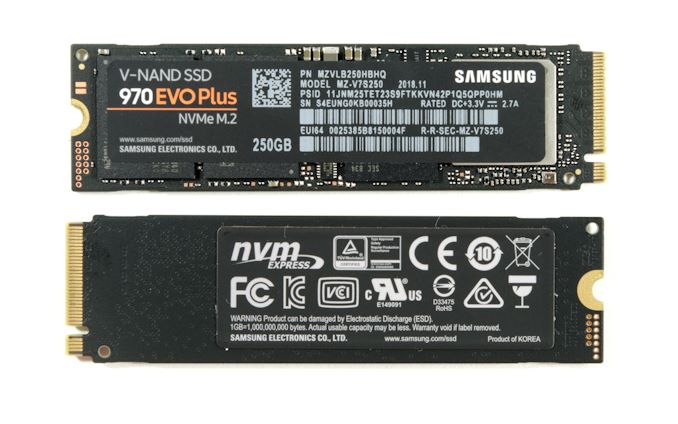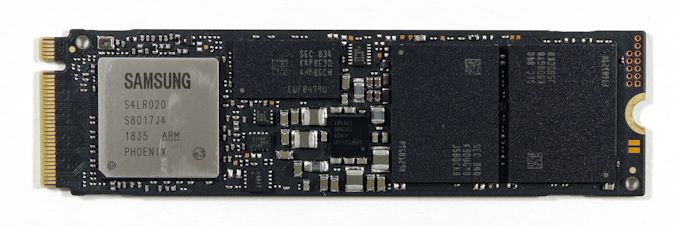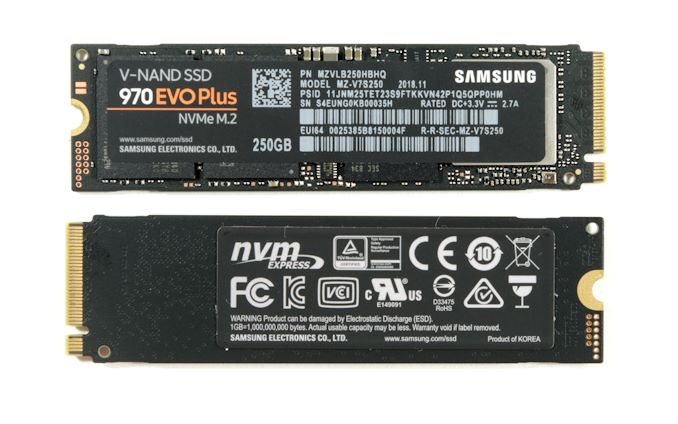The Samsung 970 EVO Plus (250GB, 1TB) NVMe SSD Review: 92-Layer 3D NAND
by Billy Tallis on January 22, 2019 10:00 AM EST
The first retail consumer SSDs to be updated with new 96-layer 3D NAND flash memory are the Samsung 970 EVO Plus. The 970 EVO Plus will be replacing the 970 EVO as Samsung's mainstream consumer NVMe SSD. Today we are reviewing two of the launch drives: the 970 EVO Plus at 250GB, and the 970 EVO Plus at 1TB. These two drives are Samsung's attack on both the mainstream and high capacity markets, while the new NAND has a focus more on power than driving down overall costs per GB. Performance per watt is a key focus of these drives.
Samsung's offerings for the 970 EVO Plus will range from 250GB to 2TB.
| Samsung 970 EVO Plus Retail Units | ||||||
| Capacity | Form Factor | Serial | MSRP | Price per GB |
||
| 250GB | 2280 M.2 | MZ-V7S250BW | $90 | 36¢ | ||
| 500GB | 2280 M.2 | MZ-V7S500BW | $130 | 26¢ | ||
| 1TB | 2280 M.2 | MZ-V7S1T0BW | $250 | 25¢ | ||
| 2TB | 2280 M.2 | MZ-V7S2T0BW (?) | April | - | ||
Capacities up to 1TB will be available from today, with the 2TB model launching in April. Pricing for that part has not yet been announced, however it is likely to be at a similar price density per GB as the 1TB.
Transitioning to 92-Layer (9xL) NAND
Last fall, Samsung outlined their plans for transitioning from 64L to 9xL NAND. Most of Samsung's SSDs that use TLC NAND will be updated to 9xL NAND while keeping the same SSD controllers as current products. While the consumer products will remain PCIe 3.0 for the time being, Samsung's top enterprise drives are getting an update to support PCIe 4.0. This means that the Samsung Phoenix controller that is at the heart of their retail, OEM and low-end datacenter NVMe product lines will be sticking around for another year, including in the new 970 EVO Plus and relatives like the PM981a and PM983a.
Samsung's fifth generation, 9x-layer 3D NAND was first announced at Flash Memory Summit in 2017, and mass production began in July 2018 with 256Gb TLC dies. However, last year saw NAND flash memory prices crash as good yields and high production volumes of 64L 3D NAND created an oversupply. The major manufacturers have been taking steps to slow their transition to 9xL NAND in order to avoid making that situation even worse for their profit margins, but they have not entirely halted the process. There's still strong incentive to provide annual updates to retail products, so it isn't surprising to see the 970 EVO Plus showing up now.
Samsung's 9xL 3D NAND process doesn't provide huge density increases to further drive costs down, but it does provide numerous performance and power efficiency improvements that make it a good way for Samsung to improve a high-end product like the 970 EVO. The new generation of 3D NAND upgrades the interface between the controller and NAND to Toggle-mode DDR 4.0, increasing the interface speed from 800Mbps to 1400Mbps while reducing the voltage from 1.8V to 1.2V. This gives Samsung the lead for another generation, as 96L NAND from Intel, Micron and SK Hynix will only support up to a 1200Mbps interface, and Toshiba/SanDisk 96L NAND is only at 800Mbps.
Within each NAND flash die, Samsung has made improvements to read and program latency, now down to about 50µs and 500µs respectively, improving by about 30%. Samsung is the only NAND manufacturer still increasing the layer count without resorting to manufacturing using string stacking, which Samsung has achieved by making each layer 20% thinner, but this has not affected the write endurance ratings for the drives. Samsung has notably fallen slightly behind in total layer count, with this generation only using 92 active layers compared to the expected 96 layers achieved by all their competitors.
| Samsung 970 EVO Plus Specifications | ||||||
| Capacity | 250 GB | 500 GB | 1 TB | 2 TB | ||
| Form Factor | M.2 2280 single-sided | |||||
| Controller | Samsung Phoenix | |||||
| LPDDR4 DRAM | 512 MB | 1 GB | 2 GB | |||
| NAND Flash | Samsung 92-layer 3D TLC | |||||
| SLC Cache | Min | 4 GB | 4 GB | 6 GB | TBD | |
| Max | 13 GB | 22 GB | 42 GB | TBD | ||
| Sequential Read | 3500 MB/s | TBD | ||||
| Sequential Write (SLC) | 2300 MB/s | 3200 MB/s | 3300 MB/s | TBD | ||
| Sequential Write (TLC) | 400 MB/s | 900 MB/s | 1700 MB/s | 1750 MB/s | ||
| 4KB Random Read | QD1 | 17k IOPS | 19k IOPS | TBD | ||
| QD128 | 250k IOPS | 480k IOPS | 600k IOPS | 620k IOPS | ||
| 4KB Random Write | QD1 | 60k IOPS | TBD | |||
| QD128 (SLC) | 550k IOPS | 560k IOPS | ||||
| QD128 (TLC) | 100k IOPS | 200k IOPS | 400k IOPS | 420k IOPS | ||
| Power | Read | 5.0 W | 5.5 W | 5.5 W | TBD | |
| Write | 4.2 W | 5.8 W | 6.0 W | TBD | ||
| Idle | 30 mW | TBD | ||||
| L1.2 Idle | 5 mW | TBD | ||||
| Encryption | AES 256, TCG Opal 2.0, IEEE 1667 | |||||
| Warranty | 5 years | |||||
| Write Endurance | 150 TB 0.3 DWPD |
300 TB 0.3 DWPD |
600 TB 0.3 DWPD |
1200 TB 0.3 DWPD |
||
| MSRP | $89.99 (36¢/GB) |
$129.99 (26¢/GB) |
$249.99 (25¢/GB) |
Launching in April |
||
Lately, Samsung has been giving more detailed performance specs than any other consumer SSD vendor, including precise SLC cache sizes and write performance after the cache is full, and random IO specifications at both QD1 and at unrealistically high queue depths. On the other hand, we don't have full specs yet for the 2TB model because it won't be shipping until April, but the press release suggests a few small advantages over the 1TB model. The smaller models use 256Gb TLC dies but the 2TB model needs the 512Gb parts in order to fit enough flash on a single-sided M.2 card.
Compared to the original 970 EVO, the 970 EVO Plus improves performance at every capacity and on every metric, but unevenly: the biggest gains are to write speeds, especially sequential writes. The 1TB model is now rated for 3.3GB/s writes to SLC cache compared to 2.5GB/s, and 1.75GB/s after the cache is full compared to 1.25GB/s. Random read speeds are about 20% better, and sequential reads see the smallest benefit with an increase from 3.4GB/s to 3.5GB/s; the PCIe 3.0 x4 interface is preventing anyone from doing much better than that.
It's interesting to note that the 970 EVO Plus performance specifications all now exceed those of the MLC-based 970 PRO, except when the SLC write cache is filled. In those cases, the 970 PRO is still rated for an advantage of 25–255% depending on which capacity is under consideration and whether the writes are sequential or random.
Hardly anything has changed about the construction of the 970 EVO Plus; the PCB layout is unchanged save for the adjustment of a few of the smallest passive components. The part numbers for the NAND packages have changed in one digit to reflect the new NAND generation and the date codes on all the major components are about a year newer. The label on the bottom of the drive still has a layer of copper foil as a token heatspreader while the label on the top is still just plastic.
Samsung did not provide price information for the full lineup before launch, but the $89.99 MSRP for the 250GB 970 EVO Plus is only slightly above the current street prices for the 970 EVO and matches what Samsung sells it for direct, so we don't expect any significant changes in the near term for the other capacities. In the long run however, NAND prices are still in decline and Samsung has had to respond to that. The original 970 EVO was initially announced for around 45¢/GB but this was cut to 40¢/GB before it even hit the shelves. Now, it's going for around 25¢/GB. Further price cuts to the 970 EVO [Plus] are likely over the coming months, but the transition from one model to another will cause some fluctuations depending on which one is in stock at more retailers on any given day.
Where's the 970 PRO Plus?
(Not to be confused with caffeine pills - Ian)
Conspicuously absent from Samsung's 9xL roadmap last fall was any mention of MLC-based drives, and in particular Samsung has not mentioned a 970 PRO Plus. The lack of new MLC drives for the datacenter or OEMs is no surprise given how thoroughly those markets have shifted over to TLC. But on the consumer side, Samsung has been one of the few remaining holdouts offering MLC-based SSDs for enthusiasts and prosumers with their PRO drives.
The later launch date of the 2TB 970 EVO Plus suggests that the only 9xL NAND Samsung is ready to release to the retail market is their 256Gb TLC; the 512Gb TLC and QLC parts are probably still in the sampling phase for either the memory itself, or the OEM or datacenter drives are still sampling rather than in full production. If Samsung plans a regular MLC part at 92 layers, it's almost certainly the lowest priority to move off 64L, after they get both TLC parts and both QLC parts out the door.
We can't rule out the possibility of a '970 PRO Plus' sometime this year, but it seems far more likely that we won't see another PRO NVMe drive until 2020 with a new controller that may also bring PCIe 4.0 support. Until then, the 970 EVO Plus takes over the performance flagship position for Samsung's retail/consumer product line and the 970 PRO is only relevant for workloads that involve sustained writes of hundreds of GB per day. For workloads that merely consist of tens of GB per day or include some disk idle time for the SLC cache to recover, the 970 EVO Plus is now likely to offer both better performance and better pricing than the 970 PRO.
(Samsung does plan to eventually introduce a MLC version of the second generation of their specialized low-latency Z-NAND, but they are still in the process of rolling out the SLC version, and Z-NAND's layer count is lagging behind their general-purpose V-NAND 3D NAND. Samsung has not mentioned any plans to use Z-NAND outside of their datacenter product lines. At the other end of their NVMe product spectrum, they've disclosed plans for a 980 QVO with QLC NAND, but we aren't sure when to expect that to launch, or whether it will introduce a new controller or continue with the Phoenix controller.)
This Review
For the review today, we are testing the 250GB and 1TB versions of the Samsung 970 EVO Plus.
| AnandTech 2018 Consumer SSD Testbed | |
| CPU | Intel Xeon E3 1240 v5 |
| Motherboard | ASRock Fatal1ty E3V5 Performance Gaming/OC |
| Chipset | Intel C232 |
| Memory | 4x 8GB G.SKILL Ripjaws DDR4-2400 CL15 |
| Graphics | AMD Radeon HD 5450, 1920x1200@60Hz |
| Software | Windows 10 x64, version 1709 |
| Linux kernel version 4.14, fio version 3.6 | |
| Spectre/Meltdown microcode and OS patches current as of May 2018 | |
- Thanks to Intel for the Xeon E3 1240 v5 CPU
- Thanks to ASRock for the E3V5 Performance Gaming/OC
- Thanks to G.SKILL for the Ripjaws DDR4-2400 RAM
- Thanks to Corsair for the RM750 power supply, Carbide 200R case, and Hydro H60 CPU cooler
- Thanks to Quarch for the XLC Programmable Power Module and accessories
- Thanks to StarTech for providing a RK2236BKF 22U rack cabinet.

















35 Comments
View All Comments
Chaitanya - Tuesday, January 22, 2019 - link
Quite a minor upgrade over previous drive.jeremyshaw - Tuesday, January 22, 2019 - link
Hence the name.Billy Tallis - Tuesday, January 22, 2019 - link
More substantial than the WD Black SN750.I don't think we'll see any more big jumps until PCIe 4.0 ships. Pretty much everybody has caught up on the NAND side, and most of the controller vendors have had decent NVMe controllers out for a while. There's no low-hanging fruit like there was when companies were still trying to make SM2260 or Phison E7 compete against Samsung with inferior NAND.
DanNeely - Tuesday, January 22, 2019 - link
More to the point it is a consistent incremental improvement. There've been far too many cases over the years when a v.next drive was an incremental improvement in manufacturing cost, that regressed in most to all performance numbers.boozed - Tuesday, January 22, 2019 - link
I call those performance improvements significant (just).Flunk - Thursday, January 24, 2019 - link
I don't think it's enough to elevate this drive over the high-end Silicon Motion drives in real-world uses. Not for consumers at least.nectrone - Thursday, January 24, 2019 - link
96-layer nand is an improvement on production speed, yields, and manufacturing cost, rather than perf. And tbh, we don't need better perf at all, or maybe a bit in 4k random, because 150MBps is a bit low in 2019. Instead, what we need, is prices to drop, below twice the price of an hdd of the same capacity.In 2018, 1TB tlc nvme 64-layer ssd was 10 times the price of an hdd, now in Jan it's 5 times. Sata 64-layer ssd were 7 times the price of hdd, now it's 3. I'd like TLC nvme to cost twice an hdd, and sata tlc to be the same price as an hdd. With 96-layer, we'll get closer to that.
haukionkannel - Tuesday, January 22, 2019 - link
Pity that the consumer version does not get 4.0 this year... I was hoping to have 4.0 compatible ssd when AMD 570x boards comes out. Well most like with my usage even these Are fast enough and I am not going to be Bottle negged by 3.0.sorten - Wednesday, January 23, 2019 - link
I had the same reaction. I'm running an old gaming PC and I'm ready to switch to AMD with a full set of upgrades at the end of the year and was hoping for PCIE 4.0, but my SSD is so old that I know any drive will be a huge improvement.ikjadoon - Tuesday, January 22, 2019 - link
Meta: has the scrolling video ad been moved to the right? It finally doesn't cover up the article when you scroll. Huge thank you.970 EVO Plus: I'm excited for this to get added to the SSD 2018 Bench. Curious how close it matches the 970 PRO 512GB, now at $170. My almost-full 250GB 960 EVO needs a capacity increase and $40 isn't a big difference for a minimum two-year purchase.